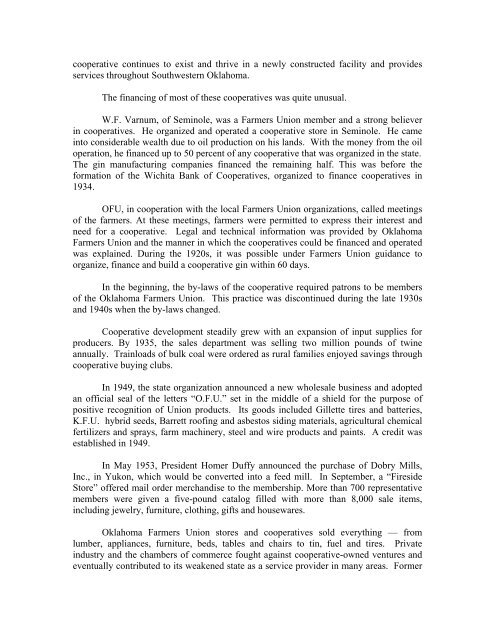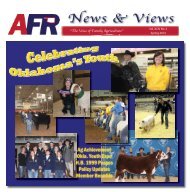Oklahoma Farmers Union - American Farmers & Ranchers
Oklahoma Farmers Union - American Farmers & Ranchers
Oklahoma Farmers Union - American Farmers & Ranchers
Create successful ePaper yourself
Turn your PDF publications into a flip-book with our unique Google optimized e-Paper software.
cooperative continues to exist and thrive in a newly constructed facility and provides<br />
services throughout Southwestern <strong>Oklahoma</strong>.<br />
The financing of most of these cooperatives was quite unusual.<br />
W.F. Varnum, of Seminole, was a <strong>Farmers</strong> <strong>Union</strong> member and a strong believer<br />
in cooperatives. He organized and operated a cooperative store in Seminole. He came<br />
into considerable wealth due to oil production on his lands. With the money from the oil<br />
operation, he financed up to 50 percent of any cooperative that was organized in the state.<br />
The gin manufacturing companies financed the remaining half. This was before the<br />
formation of the Wichita Bank of Cooperatives, organized to finance cooperatives in<br />
1934.<br />
OFU, in cooperation with the local <strong>Farmers</strong> <strong>Union</strong> organizations, called meetings<br />
of the farmers. At these meetings, farmers were permitted to express their interest and<br />
need for a cooperative. Legal and technical information was provided by <strong>Oklahoma</strong><br />
<strong>Farmers</strong> <strong>Union</strong> and the manner in which the cooperatives could be financed and operated<br />
was explained. During the 1920s, it was possible under <strong>Farmers</strong> <strong>Union</strong> guidance to<br />
organize, finance and build a cooperative gin within 60 days.<br />
In the beginning, the by-laws of the cooperative required patrons to be members<br />
of the <strong>Oklahoma</strong> <strong>Farmers</strong> <strong>Union</strong>. This practice was discontinued during the late 1930s<br />
and 1940s when the by-laws changed.<br />
Cooperative development steadily grew with an expansion of input supplies for<br />
producers. By 1935, the sales department was selling two million pounds of twine<br />
annually. Trainloads of bulk coal were ordered as rural families enjoyed savings through<br />
cooperative buying clubs.<br />
In 1949, the state organization announced a new wholesale business and adopted<br />
an official seal of the letters “O.F.U.” set in the middle of a shield for the purpose of<br />
positive recognition of <strong>Union</strong> products. Its goods included Gillette tires and batteries,<br />
K.F.U. hybrid seeds, Barrett roofing and asbestos siding materials, agricultural chemical<br />
fertilizers and sprays, farm machinery, steel and wire products and paints. A credit was<br />
established in 1949.<br />
In May 1953, President Homer Duffy announced the purchase of Dobry Mills,<br />
Inc., in Yukon, which would be converted into a feed mill. In September, a “Fireside<br />
Store” offered mail order merchandise to the membership. More than 700 representative<br />
members were given a five-pound catalog filled with more than 8,000 sale items,<br />
including jewelry, furniture, clothing, gifts and housewares.<br />
<strong>Oklahoma</strong> <strong>Farmers</strong> <strong>Union</strong> stores and cooperatives sold everything — from<br />
lumber, appliances, furniture, beds, tables and chairs to tin, fuel and tires. Private<br />
industry and the chambers of commerce fought against cooperative-owned ventures and<br />
eventually contributed to its weakened state as a service provider in many areas. Former



